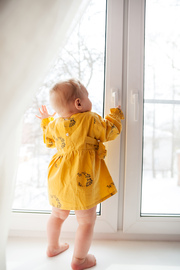Ten Tips for Child Safety at Home
Home is supposed to be a safe haven for your children, but it’s also where most accidents happen. According to the Centers for Disease Control and Prevention (CDC), unintentional injuries are the leading cause of death for children in the United States. This is why it’s important to take child safety seriously and put measures in place to prevent accidents from happening.
Whether you’re a new parent or have been raising children for years, it’s always a good idea to review your home’s safety measures. In this article, we’ll provide you with ten practical tips to help you create a safer environment for your child. By following these tips, you can ensure that your child’s home is a safe and secure place to grow and play.
Teach Kids to Keep the Doors Locked
Teaching kids to keep doors locked is a safety measure that can protect them from potential intruders or strangers who may try to enter their homes without permission. By keeping doors locked, children can prevent unauthorized access and ensure their safety and security.
Baby Proof Your Draws and Cupboards
Babies and toddlers are naturally curious and love to explore their surroundings, including cabinets, drawers, and other storage areas. Unfortunately, these areas can contain dangerous items such as sharp objects, cleaning chemicals, and other harmful substances that can cause injury or illness if ingested or come into contact with their skin.
By baby-proofing your drawers and cupboards, you can prevent your child from accessing these hazardous items. This can be done by installing childproof locks or latches on the cabinets and drawers to prevent your child from opening them.
Keep Medicine Out of Reach
Medicine should be kept out of reach of children because they are often curious and may mistake medication for candy or other treats. Children can accidentally ingest medicine, leading to serious health consequences or even death. It goes without saying that some medicines are not meant for children and may cause harm if taken by them.
Create a Tranquil and Safe Sleeping Environment for Babies
Creating a tranquil and safe sleeping environment for babies is crucial for their overall health and well-being. A peaceful and quiet environment can help babies fall asleep faster and stay asleep longer, which is essential for their growth and development.
Safe sleep for babies includes providing them with the right cot, clothing, and linen. Babies shouldn’t have stuffed animals in their cots or loose blankets. Swaddled babies should be placed on their backs to prevent suffocation. Ensure your baby can’t roll over onto their stomach when they’re sleeping.
Additionally, it’s crucial to stay informed about the well-being of your baby as they grow. Understanding when to stop swaddling a baby is an essential aspect of promoting safe sleep practices. For more insights on this topic, you can explore information on when it is best to stop swaddling a baby.
Place Rubber Mats in Baths and on The Floor
Rubber mats provide a non-slip surface that reduces the risk of slips and falls, which are common causes of injuries among children.
Children are often active and energetic, and this can lead to accidents in the bathroom or on slippery floors. By placing rubber mats in these areas, parents and caregivers can create a safer environment for children to play and move around in. And speaking of bathrooms, consider a child proof door knob to keep toddlers from accessing the toilet water.
Block Off Stairways
Blocking off stairways is important for child safety because it can prevent falls and serious injuries. Young children may try to climb up or down stairs without adult supervision. This can be dangerous, especially if the child is not yet confident in their ability to navigate the stairs safely. Place a gate at the top and bottom of the stairs to prevent your little ones from getting onto the staircase.
Put Padding on Corners
If a child were to accidentally bump into a sharp corner, they could sustain serious injuries such as cuts, bruises, or even head injuries. Place padding on corners of tables, cabinets, and even windowsills to prevent accidents.
Don’t Allow Children to Jump on the Bed
Jumping on the bed can be fun, but it’s also a hazard. The bed frame could break under the weight of multiple kids jumping on it, resulting in injury or worse. Jumping can also cause the mattress to move around and possibly flip, which can cause children to fall onto the floor and be injured.
Provide Your Baby with Plastic Cutlery
Metal cutlery or sharp knives should never be given to children to eat with. These utensils can cause serious harm to your baby, especially if they have underdeveloped motor skills. Provide your baby with a rubber teaspoon to eat with. Plastic forks can be given to toddlers, and as children get older, they can start using metal cutlery.
Cover Electric Plugs
Electric plugs can pose a serious danger to children if they are not covered properly. An uncovered electric plug can cause electrocution, burns, or other injuries if a child puts their fingers or objects like metal utensils into the outlet. Covering electric plugs with child safety covers can prevent these accidents from happening and protect children from harm.
Final Thoughts
Implementing these ten tips for child safety at home can help provide a safe and secure environment for your children.
By taking proactive measures to prevent accidents and hazards, you can give yourself peace of mind knowing that your children are protected. Remember to regularly review and update your safety measures as your children grow and develop new abilities.
Additional Resources:
- Research home safety tips for households with young children and elders.
- Explore babyproofing steps you shouldnt forget about.





